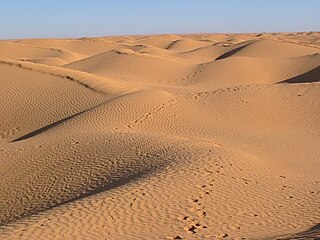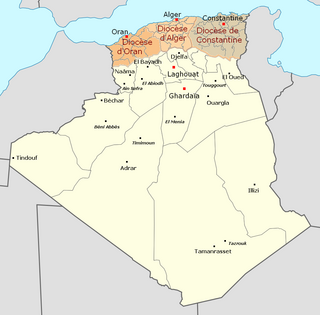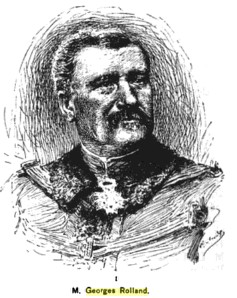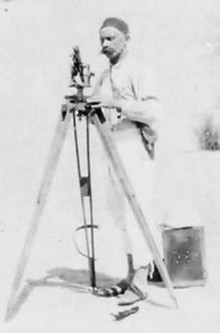Algeria, since December 18, 2019, is divided into 58 wilayas (provinces). Prior to December 18, 2019, there were 48 provinces. The 58 provinces are divided into 1,541 baladiyahs (municipalities). The name of a province is always that of its capital city.

Ghardaïa is an Algerian province located in the north of the Algerian desert. Its administrative center is the city of Ghardaia, located 600 km (370 mi) south of the capital Algiers. Its total area is estimated at 21,224.03 km2 (8,194.64 sq mi), 138 km (86 mi) from north to south, and 200 to 250 km from east to west. It rises 486 m (1,594 ft) above sea level.

Laghouat is one of the fifty-eight provinces (wilaya) of Algeria. It is located in the north central part of Algeria. The province borders Tiaret Province to the north, El Bayadh Province to the west, Ghardaia Province to the south and Djelfa Province to the east. The capital of the province is Laghouat City. The province is famous for palm trees and livestock.

Charles Martial Allemand Lavigerie, M. Afr. was a French Catholic cardinal, Archbishop of Carthage and Algiers and Primate of Africa. He also founded the White Fathers.

The M'zab or Mzab is a natural region of the northern Sahara Desert in Ghardaïa Province, Algeria. It is located 600 km (370 mi) south of Algiers and there are approximately 360,000 inhabitants.

The White Fathers, officially the Missionaries of Africa abbreviated MAfr), are a Roman Catholic society of apostolic life of Pontifical Right founded in 1868 by then Archbishop of Algiers Charles-Martial Allemand-Lavigerie.

Ghardaïa is the capital city of Ghardaïa Province, Algeria. The commune of Ghardaïa has a population of 93,423 according to the 2008 census, up from 87,599 in 1998, with an annual growth rate of 0.7%.

The Archdiocese of Bamako is the Metropolitan Archdiocesan See for the Ecclesiastical province which covers all and only Mali. It depends on the missionary Roman Congregation for the Evangelization of Peoples.

The Grand Erg Oriental is a large erg or "field of sand dunes" in the Sahara Desert. Situated for the most part in Saharan lowlands of northeast Algeria, the Grand Erg Oriental covers an area some 600 km wide by 200 km north to south. The erg's northeastern edge spills over into neighbouring Tunisia.

The Diocese of Laghouat is a Latin Church ecclesiastical jurisdiction or diocese of the Catholic Church covering the sparsely populated Saharan inland of Algeria.

The following outline is provided as an overview of and topical guide to Algeria:

The Catholic youth sports associations of French Algeria first appeared in major cities in northern Algeria at the beginning of the 20th century and were mainly reserved for young European people. By the start of the First World War some of the associations had joined the Fédération internationale catholique d'éducation physique et sportive, with women's organizations rapidly following suit and joining the Rayon sportif féminin – a French catholic sporting organisation for women. In contrast to the situation in the North, the spread of sports through the southern regions of Algeria, under the auspices of the White Fathers, predominantly involved the indigenous populations.

Adolphe Lechaptois, M. Afr. was a priest of the White Fathers missionary society who was Vicar Apostolic of Tanganyika from 1891 until his death in 1917, in what is now Tanzania. He took responsibility for the vicariate at a time of great danger, when the missions were insecure havens for people fleeing slavers. As the country settled down, he oversaw expansion in the number of missions and schools. He was the author of a book on the ethnography of the local people that won a prize from the French Société de Géographie.

Georges Rolland was a French geologist and industrialist, a member of the Corps des mines, who worked in Algeria in the 1880s. He made important discoveries about the underground hydrology of the Sahara. He was a leading advocate of a trans-Sahara railway to link French colonial possessions in West Africa. After returning to France he explored the geology of the Briey iron ore basin in Lorraine. He married the heiress of a Lorraine steelworks, and became president of the Société métallurgique de Gorcy and the Aciéries de Longwy, and director of various other enterprises.

Paul Flatters was a French soldier who spent a long period as a military administrator in Algeria. He is known as leader of the Flatters expedition, an ill-fated attempt to explore the route of a proposed Trans-Saharan railway from Algeria to the Sudan. Almost all members of the expedition were massacred by hostile Tuaregs. The survivors resorted to eating grass and to cannibalism on the long retreat through the desert. After a brief outburst of public indignation the fiasco was forgotten.

Gaston Méry was a French explorer. He was born in French Algeria, son of one of the early settlers. After serving as a sailor and in the army, he assisted in surveys in Tunisia, then undertook three major expeditions into the Sahara in southern Algeria. He established friendly contact with the Tuareg people of the Kel Ajjer confederation, at the time considered unfriendly to the French, and mapped part of the route for a projected trans-Sahara railway to link Algeria to the Sudan. In the last years of his life he became a prosperous trader and real estate developer in Timbuktu.

Augustin Prosper Hacquard was a French missionary who became Apostolic Vicar of Sahara and Sudan in 1898. After several years in Algeria, including a short period as head of the Armed Brothers of the Sahara, he was appointed to the French Sudan, the newly acquired territories along the Niger River to the east of Senegal, where he established several mission stations. The missionaries founded several villages, where they settled former slaves.

Anatole-Joseph Toulotte was a French White Fathers missionary who was Vicar Apostolic of Sahara and Sudan from 1893 to 1897. Under his leadership the first White Fathers missions were established in the French Sudan (Mali) at Ségou and Timbuktu. A solitary, ascetic person, he was not a natural leader and drove himself too hard without regard for his health. He retired in 1897 due to physical and mental exhaustion after a long trip in West Africa. He is known as coauthor of a monumental history of Christian Africa in ancient times.

The Trans-Saharan slave trade, also known as the Arab slave trade, was a slave trade in which slaves were transported across the Sahara. Most were moved from sub-Saharan Africa to North Africa to be sold to Mediterranean and Middle Eastern civilizations; a small percentage went the other direction. Estimates of the total number of black slaves moved from sub-Saharan Africa to the Arab world range from 6-10 million, and the trans-Saharan trade routes conveyed a significant number of this total, with one estimate tallying around 7.2 million slaves crossing the Sahara from the mid-7th century until the 20th century when it was abolished. The Arabs managed and operated the trans-Saharan slave trade, although Berbers were also actively involved.

Slavery is noted in the area later known as Algeria since antiquity. Algeria was a center of the Trans-Saharan slave trade route of enslaved Black Africans from sub-Saharan Africa, as well as a center of the slave trade of Barbary slave trade of Europeans captured by the barbary pirates.


















